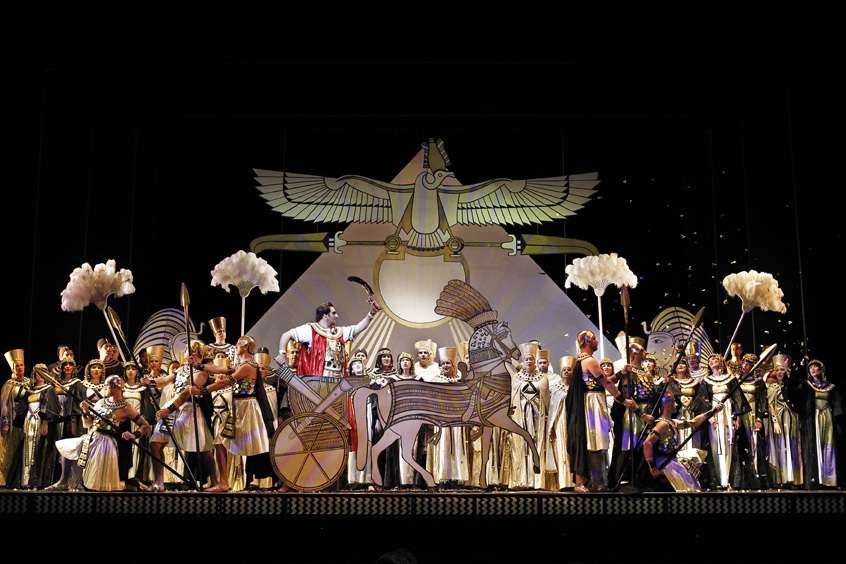|
Back
More is never Enough Melbourne
State Theatre
04/22/2013 - & April 24*, 27, 29, May 1, 4, 7, 9, 11, 2013
Giuseppe Verdi: Aida
Daria Masiero (Aida), Carlo Barricelli (Radamès), Deborah Humble (Amneris), Michael Honeyman (Amonasro), David Parkin (High Priest), Jud Arthur (The King), Natalie Aroyan (High Priestess), John Longmuir (Messenger)
Opera Australia Chorus, Michael Black (Chorus Master), Orchestra Victoria, Renato Palumbo (Conductor)
Graeme Murphy (Director/Choreographer), Roger Kirk (Set & Costume Designer), Damien Cooper (Lighting Designer), The Brothers Gruchy (Projection Design)

(© Jeff Busby/Opera Australia
Acclaimed Australian Choreographer and Director Graeme Murphy’s production of Aida for Opera Australia is now over three years old and this re-presentation in Melbourne following performances in Sydney captures a comic-book vision of Ancient Egypt. There is nothing reserved, refined or dignified about this production. It unashamedly makes a grab for every eye-catching opportunity to parade its vision of glitz and glamour before the audience. One could be forgiven for reaching the conclusion that in the Egypt of Aida and Radamès even the slaves wore gold, sparklers and lots of jewellery. It seemed, from the first act that no surface was going to be unused when it came to the lavishing of sparkles and gilt.
Designer Roger Kirk has been given carte blanche to fantasise his vision of life along the Nile. The stage is dominated by a white pyramid projection screen and the sparse elements of the set are huge black and white cartoons of columns, sphinxes and statuary. Projected onto every surface and sometimes over the entire area of the stage, designs ranging from re-imagined hieroglyphs to Op and Pop-Art add yet another layer of colour and movement to a very crowded agenda.
Curiously, the stage apron is dominated by a swimming pool Nile flanked by moving walkways reminiscent of airport conveyor belts. Elements of scenery, members of the chorus, Triumphal Trumpeters and occasionally, principal singers (mid-aria) are transported from one side to the other of the stage. As an audience member, I found my attention drifting to the many aspects of the scenic presentation competing for my attention.
Italian Maestro and Verdi specialist Renato Palumbo makes his debut for Opera Australia with this season of performances. His reading of the score is richly textured and makes full use of the talents of Orchestra Victoria. At times, Verdi’s use of brass is almost overpowering and Maestro Palumbo showed restraint and judicious use of the pianissimo in many of the more intimate passages. It was during the many orchestral/dance sequences that the true quality of his interpretation became apparent. The orchestra achieved high standards in this performance.
As Radamès, Italian-Australian tenor Carlo Barricelli was under-voiced for much of the performance. His upper register was tight and his delivery of the "Celeste Aida" lacked both emotion and strength. Only in the latter numbers of the opera did his voice truly penetrate.
Italian soprano Daria Masiero was similarly under-voiced. In the early acts she worked hard to make her presence felt above the orchestra which while powerful was not overwhelming. Her duet with Amneris in the second act was by contrast compellingly delivered. Whether it was Murphy’s direction or her stage persona, Ms Maiero tended to “stand and deliver” rather than act the part.
German-based Australian mezzo Deborah Humble was the most complete of the major characters in that she acted the part of the vengeful and besotted princess believably. From her appearances at the front of the stage, we saw a confident and strong performer. When called upon by the staging to contribute from upstage, we lost her voice to the other elements of the ensemble.
The three principal men not already mentioned: The King, Amonasro, and the High Priest, interpreted by Jud Arthur, Michael Honeyman and David Parkin respectively delivered powerfully-voiced, plausibly acted and convincing performances. All three have rich tones which demand attention and dominate the action when they are on stage. Michael Honeyman’s Amonasro was at times a touching portrait of the blood-thirsty warrior king torn by his love for his enslaved daughter.
Opera Australia’s Chorus were precise and disciplined in their delivery. Given the hectic nature of the production, they were required to move about, pose static tableaux or provide off-stage accompaniment to the on-stage action. They delivered a polished and admirable performance.
Whether Graeme Murphy’s Aida is an Opera with dancing or a Ballet with singing became a point of debate. Every opportunity is taken by Murphy to return to his roots on the ballet stage by including dancers. Every quiet orchestral sequence is choreographed with dancers appearing to proffer a kind of commentary upon the action of the opera. This became distracting at times with the dancers in Amneris’ apartments in act two delivering an entirely separate action to the singing.
At times, there was just too much happening on stage to follow: crowded multitudes, endless use of gold, sparkles and accessories and then frenzied light projections which ranged from pseudo-60’s ‘flower power’ to spiralling and spinning Op-Art.
This was a vision of Aida which contained many elements of pantomime. It endeavoured to put the “Grand” into Grand Opera by adding more and more visuals, colour and movement.
Gregory Pritchard
|